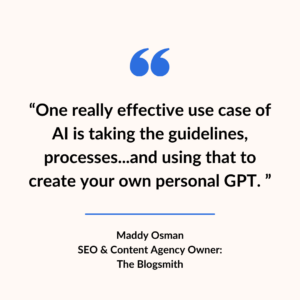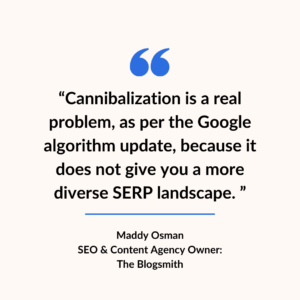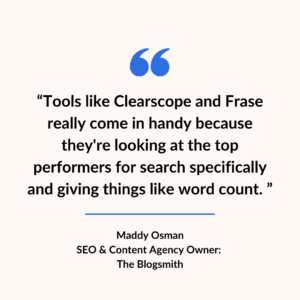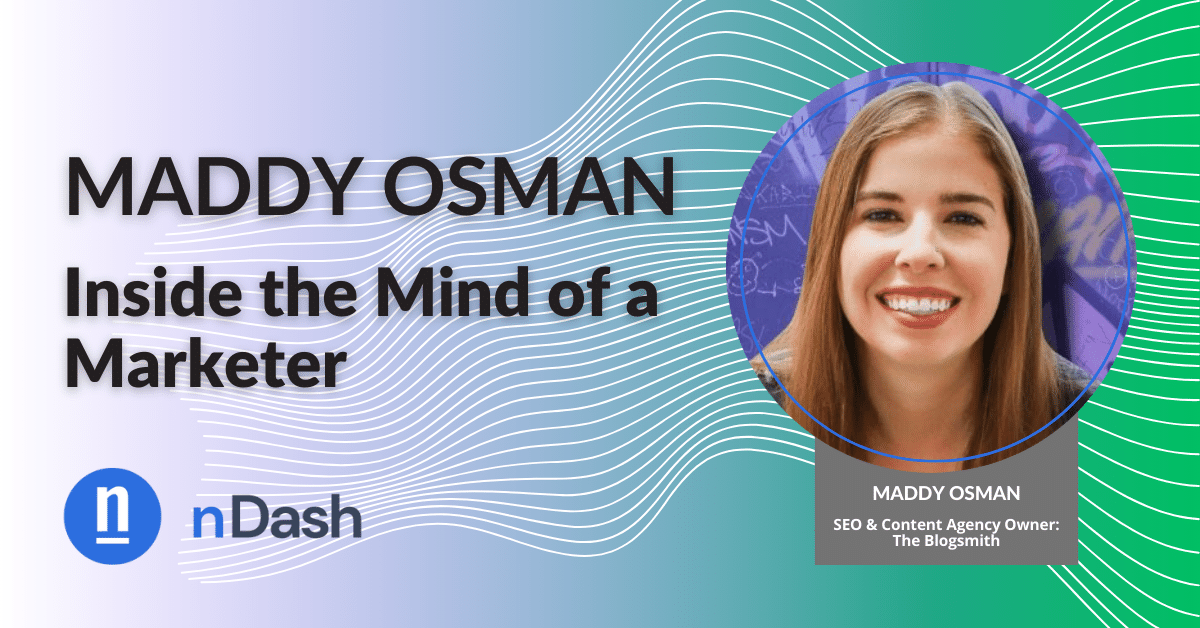We’re back with another marketer interview as part of our “Inside the Mind of a Marketer” series. This time, we’re talking to marketer Maddy Osman, SEO and content agency owner of The Blogsmith, about SEO, AI, and more!
nDash’s Interview with Maddy
Jenn: So, to start with, could you tell me a little bit about how you became an SEO content strategist and marketer?
Maddy: I started as a web designer, which was my childhood hobby. Then, it turned into a job in college. At the same time, I had the opportunity to create content for our university’s Student Life Blog and social channels. And I did some freelancing with content and web design.
Eventually, after graduating, I quit my nine-to-five job so that I could do my freelance work full-time. I really liked content the most, more so than creating the design that the content lives on. I played around with different digital marketing tactics to figure out what I liked the most.
That’s how I discovered SEO. It was just one way to get traffic to this lifestyle blog I created for fun. I went into freelance writing full-time. Then, I decided
to scale that to an agency model, where we focus on the SEO side of things, not exclusively. But that’s a big part of what we do.
 Jenn: Google’s approach to SEO as a strategy has changed dramatically. Maybe that’s not the right phrasing, but have you encountered any roadblocks, or what challenges have you encountered?
Jenn: Google’s approach to SEO as a strategy has changed dramatically. Maybe that’s not the right phrasing, but have you encountered any roadblocks, or what challenges have you encountered?
Maddy: The biggest one might be even more from the client side. I have clients who are experimenting with AI, which they should. I think that it’s a great tool, a great sort of assistant/copilot for us as a marketer.
But some are taking it to the extreme, looking to AI as a complete replacement for content writing and content strategy. From the perspective of a marketer, I think that’s a miss for many reasons. One of them is that I think of AI-generated copy as plagiarism. Why? Because it uses other people’s work, whether it’s copy or image creation, without any attribution to them.
But the other big mistake is that people who do that are giving these AI tools a prompt and accepting the output without any further action. Instead of using AI to get from step one to step two, they’re trying to go from step one to step 10 all at once.
Jenn: You mentioned that you feel AI plagiarizes. As a marketer, do you think there are any good use cases for AI, like ideation or outlining?
Maddy: Totally. I think it’s great for getting from one step to the next step. That’s how I think people should look at it. It helps you maybe go from a blank page to havi
ng some ideas. Or, on the flip side, maybe you’re done with a draft, but it could suggest some edits.
One really effective use case of AI is taking the guidelines, processes, and any sort of documentation that you’ve already created, that you’ve spent a lot of time on, and that you’re really thoughtful about, and using that to create your own personal GPT.
For example, I have a Blogsmith style guide GPT, which I fed our style guide. Then I’ll give it a piece of copy and ask it, “Does this follow our style? If not, tell me why.” Because I’ve created dozens of pages of guidelines – that’s a great use case. And it’s training on my own content. It’s narrowed in on a very specific purpose.
I have another one that’s very similar, but it’s for social media, kind of like style guidance and approach and topics and things like that. So, I haven’t used it to generate social copy completely, but it could be a great idea generator. I’ve put a lot of thought and effort into creating these guidelines for my team. Now, I think I could use them to help me with ideas and give me a starting point. I think that’s a great use of AI. It’s helping you be more efficient with the content and guidelines you’ve already created.
Jenn: Do you think AI might be a good use for keyword research, or do you think it’s just not there yet?
Maddy: It could be good for generating ideas. But it doesn’t necessarily have the data sources of All-In-One SEO tools like Ahrefs, Semrush, or Moz, so that’s the limitation. It’s not backing up ideas with data, but it could be a great way to find phrase variations.
Jenn: You mentioned the tool, Frase. Do you lean more on Frase, or do you use Clearscope? What’s your experience with those kinds of tools?
Maddy: We use both. I was really lucky to get a lifetime deal for Frase when it first came out, so we have unlimited documents. I use Frase more on the front end of our process when we’re doing our initial keyword and topic research. Frase is a really good briefing tool.
Then, we use Clearscope on the back end. If I had to choose one, I think Clearscope’s data would be a little more fine-tuned for the topics that we write. And I love the Clearscope team. So, we use Clearscope more on the back end as a content optimization tool.
Jenn: Do you find that either one of those tools or other tools may pose an issue with keyword stuffing or keywords that aren’t quite aligned with the message you want to convey?
Maddy: There’s a chance for that with any SEO approach if you’re not considering the human reader that you’re trying to write for. So, you have to use your judgment; you don’t want just to follow the suggestions of those tools blindly.
But the suggestions they give are useful for helping to understand the pieces as a whole. For example, you might see what sections need to be incorporated, or you might see keywords that represent competitors. If you get keyword suggestions about competitors, you might not want to talk about them. Still, if you’re going to rank in relevant searches, it really behooves you to find a way to talk about them in such a way that positions you the way you want to be positioned.
So, take it with a grain of salt. Like anything in SEO, it depends.
Jenn: Along the lines of competing pages, I want to ask you about cannibalization. Do you have any tips for someone who might be new to SEO? About that? I don’t think marketers really talk about that a lot.
 Maddy: In general, you don’t want to rank more than one page for the same primary keyword. That being said, you can certainly use a primary that’s
Maddy: In general, you don’t want to rank more than one page for the same primary keyword. That being said, you can certainly use a primary that’s
already designated to a certain page on other pages as a secondary or a semantic keyword.
I think that’s part of a good strategy. In general, it’s good to track these things. Use a tool like Airtable or Google Sheets just so that you know which page is optimized around which keyword, and do it for every piece in your content library.
Essentially, the negative that can happen here is that you’re putting all these efforts into creating content, and then only one page per primary keyword is likely to rank. One of Google’s past major algorithm updates specified that only one domain would come up in a relevant search for a specific primary keyword. If you had two pages that were very similar, Google’s only going to rank one, at least in the top, one or two pages of search.
Cannibalization is a real problem, as per the aforementioned Google algorithm update, because it does not give you a more diverse SERP landscape. You’ll only get one result in the top results, at most. Again, this could have changed with some of the more recent updates, but that has traditionally been Google’s intent.
Jenn: How would someone who is strategizing a hub-and-spoke content strategy approach avoid cannibalization like that?
Maddy: I think it’s about planning — being clear on what pages are going to be part of that hub and spoke and making sure that you don’t have other content on your site already covering those topics as a primary keyword. And if you do, maybe repurpose it.
So maybe it’s updating it and redirecting, if necessary, the URL so that it fits with this new structure. With anything in content, if you’re going forward without a plan, you’re planning to fail.
Jenn: Do you find that those hub and spoke strategies work better than other strategies? As far as SEO goes?
Maddy: It depends on what you’re going for. We worked with this one client who—this might not be exactly what you’re asking—but we created a bunch of dictionary content for them. It was structured like, ‘the financial concept, what is… fill in the blank.’ All of this content came from a central hub, which I guess you could describe as a dictionary.
Certain niches and industries work really well for this. It is nice to separate that content from your main blog, which may have a totally different topical focus and an entirely different audience.
So it depends on the goal, ultimately, and really the industry and how much education you have to do. It also depends on where the different members of your audience lie in a sales funnel by the time they go to your website. It’s a factor of a lot of different things.
Jenn: As a marketer, do you find it more difficult or easier to rank for specific niches, such as finance versus technology or lifestyle versus health?
Maddy: In a roundabout way of answering your question, but going back to the AI content idea. My husband is an engineer; he’s in cybersecurity, and he was telling me about how he was looking at some product manuals he was helping a client implement. He was telling me how a lot of the results that he was seeing were just really blatantly bad AI content. And it ranked because that’s all that there was, right? Not a lot of topic/industry competition.
For my husband’s search use cases, this industry is ripe for getting some good content ranking. Whereas something like the industry that I live in and work in, which is B2B Tech, it’s hard to rank at this point.
Jenn: When you’re working on your SEO strategy, how do you balance content that ranks and content that also engages with your audience? Is that difficult to do sometimes, or do you have a specific flow?
Maddy: I think that’s a common worry or struggle that people have—how do you combine them? For example, the SEO articles versus the thought leadership pieces, the super shareable social assets, or whatever. I’m of the mind that you don’t have to pick between the two, of course. It requires a very thoughtful approach.
Again, I think it comes back to the idea that I feel very strongly about, which is to write for humans. The SEO piece is important because it creates descriptiveness, which then creates indexability. It creates things that an algorithm can latch on to and find and uncover.
But there is a way to make both happy. And so you just have to keep that in mind. I think it’s important to create and follow standards for everything you write.
For example, we’re always thinking about the visuals. That’s something that could be useful to the search engine spider. We use descriptive alt tags, name the files with the keywords we’re incorporating and things like that.
But ultimately, it appeals to the human reader because everybody learns differently, and everyone interacts with media differently. So, I don’t think it has to be one or the other. I think sometimes, when it comes to thought leadership, there might not be keyword research to support your article. Maybe you’re talking about something so new that there’s no data to back up demand.
There’s also a case for zero-search-volume keywords. We wrote an article about this on our blog, but one of the examples was the word “Barbeneimer.” Back when Barbie and Oppenheimer came out at the same time, it was like, well, there’s no search volume for that. But then it became a big term, right? And then there suddenly was search volume!
We wrote an article about AI detectors and whether they’re reliable or not. We had no keyword data to justify writing that topic, but we wrote it, and now it’s one of the highest referrers from search to our website.
You don’t have to focus on one audience (humans and robots) at the expense of the other. You just have to be thoughtful in your approach.
 Jenn: There’s a lot of debate about whether content should be lengthy, full of data, numerical data, and lots of names, or whether it should be quick-read, snackable content that maybe has one image or a video or something. Do you find that one kind of content performs better than the other in terms of length and depth?
Jenn: There’s a lot of debate about whether content should be lengthy, full of data, numerical data, and lots of names, or whether it should be quick-read, snackable content that maybe has one image or a video or something. Do you find that one kind of content performs better than the other in terms of length and depth?
Maddy: Like everything with SEO, it depends. So, there’s no blanket answer that will correctly address that for every piece of content. Tools like Clearscope and Frase really come in handy because they’re looking at the top performers for search specifically and actionable data like ideal word count. Surfer will also tell you things like how many images the top-ranking articles incorporate. Some or all of those tools will tell you how many headings to ideally incorporate, which is a measure of how in-depth the topic gets.
But if you take search out of the equation, then does long-form matter much? I don’t know. If you’re writing content for social media, certainly, in most cases, a shorter-form approach is going to be better. Social content also requires different image standards. So again, it depends on the medium, the topic, and the audience.
Jenn: What skills do you think someone should have if they want to become a good SEO strategist?
Maddy: It probably helps to have some sort of writing background because you’re going to have to deal with content in some way. There are different aspects of SEO that get more technical, but you still have to like content, which is still a part of a successful strategy.
You should at least be able to recognize what’s good. I think you have to have curiosity. You have to be interested in the inner workings of the algorithm. And while Google doesn’t tell us everything, they give us a lot of breadcrumbs that we can pick up, like the search quality rater guidelines. This almost 200-page document goes into great depth with many examples of how Google interprets quality and the ability of a page to meet needs.
It doesn’t directly influence the algorithm, but it tells us a lot about how Google interprets things. So, that’s one thing that I’ve read through painstakingly, and it’s not a particularly fun read, but it’s good for me as an SEO to have that foundational knowledge.
And I guess you have to be a little analytical. I’m not what I would consider to be a numbers person, but I think that it is important to have some basic understanding of data analysis when it comes to using tools like Search Console or Google Analytics. Understanding how to operate the SEO tools themselves effectively is crucial.
Understanding how to make sense of a relevant SERP—who’s ranking, how competitors’ domain ratings compare to yours, and things like that—is key. You have to juggle and weigh factors like keyword difficulty and other numeric elements.
So, it’s not as complicated necessarily as creating your own algorithm to rank. But there are factors that you still have to weigh against each other.
Jenn: As a marketer and strategist, how much value do you think backlinking holds?
Maddy: I think it holds a lot of value. Again, it’s not the only thing. I see SEO as having three pillars. Every SEO has its own definition of this. But to me, it’s on-page, which is content. It’s the metadata. It’s how you incorporate images with alt text. It involves how you use internal and external links.
Then, off-page is the backlinks; it’s any other outside source lending its authority to help Google understand where you lie in the pecking order. Then, the last piece is the technical structure of your website—are things working, is everything easy to index, or are there broken pages, image files, or links? It’s a third of the equation if we go by that model. I think it’s on par with the other things. It’s not more important. It’s just as important.
Jenn: Last question – what advice do you have for someone who would like to become an SEO strategist or marketer?
Maddy: What I did, which I think was effective, is make your own blog or website with content and experiment with those different pillars, learning about how they work and how to measure whether they’re working or if something’s broken.
Be a student of what other people are doing. Find some mentors, whether it’s an official mentorship or you admire them from afar but read everything they write. They publish and replicate some of the things they’re doing, Steal Like an Artist. But yeah, like, become a student in every way of the craft, not just act and see what happens.

Want to connect with marketer Maddy Osman and learn more about what she’s doing? Check her out on LinkedIn. You can also visit her site to learn more about her book, Writing for Humans and Robots.
